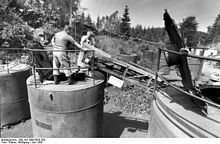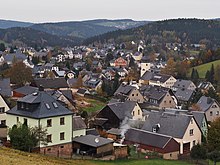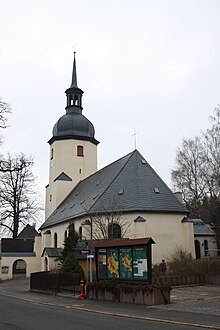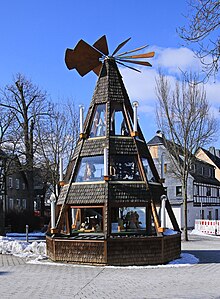Sosa (yew tree)
|
Sosa
City of Eibenstock
|
||
|---|---|---|
| Coordinates: 50 ° 29 ′ 57 ″ N , 12 ° 39 ′ 7 ″ E | ||
| Height : | 604 m | |
| Area : | 21.99 km² | |
| Residents : | 2046 (May 9, 2011) | |
| Population density : | 93 inhabitants / km² | |
| Incorporation : | January 1, 2011 | |
| Postal code : | 08309 | |
| Area code : | 037752 | |
|
Location of Sosa in Saxony |
||
Sosa has been part of the town of Eibenstock in the Ore Mountains since it was incorporated on January 1, 2011 .
geography
location
Sosa is located in the Western Ore Mountains . According to the natural map of Saxony it belongs to the mesogeochore "Bockau plateau" and within this to the microgeochore "Sosaer Zerschneidungs-Hang". The place extends on both sides of the Sosabach at an altitude between 550 and 817 m above sea level. NHN. The groups of houses Rote Grube and Riesenbergerhäuser also belong to Sosa . The state road S 274 leads through the village from Neustädtel to Schwarzenberg . The connection to the Chemnitz – Aue – Adorf railway via the Blauenthal station, 3 km away, which had existed since 1875 , was finally dropped in 1995.
Neighboring places
| Blauenthal | Albernau | Bockau |
| Eibenstock |

|
Hunter's House |
| Wildenthal | Steinbach | Erlabrunn |
history
Name and language
The origin of the name Sosa is not clear. In 1413 the place was first mentioned as zu der Saßa . Other names such as Sassaw (1456), Sasse (1474), Zoza (1529) or Sassa (1550) can be traced back to the Middle High German word sāʒe , which means something like settlement or residence. Other derivations refer to words of Slavic origin or to a connection with immigrant miners from the Harz Mountains.
In Sosa, the German dialect Erzgebirge is spoken , the subdialect Westerzgebirgisch, which is why its inhabitants also call their place de Sose .
Foundation and development until 1900
Sosa emerged as a forest hoof village . At the beginning of the 20th century it was assumed that the first settlers were of Slavic origin (also called Wends or Sorbs), recent research has come to the conclusion that the settlement of the Ore Mountains began in the second half of the 12th century At the instigation of the Schwarzenberg rulers, eight non-owned farmers from the vicinity of Sulzbach in the Upper Palatinate settled here and founded the place around 1200. The year 1207 was set as the year of foundation and the starting point for the 800th anniversary. In 1453 the place was first mentioned as Sossaw when Elector Friedrich von Sachsen founded the brothers Leonhart and Nickel von Tannenberg auf Plohn a. a. enfeoffed with the villages of Eibenstock, Sosa and Burkhardtsgrün .
While the inhabitants initially lived on agriculture, cattle breeding and forestry, mining and the associated charcoal craft , which is continued in the last still producing charcoal factory in the Ore Mountains , gained increasing importance. Mining experienced its heyday between 1650 and 1750. Mainly tin and iron ore were mined , but bismuth and cobalt were also mined until the end of the 19th century . With Bingen (e.g. Erzengelbinge), dilapidated tunnels and heaps , evidence from this time can still be found. In 1705, Elector Friedrich August I of Saxony confirmed a mountain brotherhood in Sosa. In phases of decline, miners migrated e.g. B. in the Zwickau coal mining area or tried with their family members by carving, peddling, lace making, bead embroidery and collecting herbs to ensure their survival.
In his story of the Saxon mountain town of Sosa in the Meisnian Upper Ore Mountains , the pastor and chronicler Christian Heinrich Hecht described a whole series of decisive events that increased the general plight of the population. In the years 1599, 1630 and 1634 many people died from the plague. At the time of the Thirty Years' War in 1640 the "Baumerschen Reuter" invaded and "plundered". In August 1661 there was a severe flood. During the Seven Years' War in 1758 a. a. "A squadron of imperial hussars" and also in the following years several troops passed through the place. In 1772 "the inflation and famine rose to the highest" and there was also a " lazy fever which took away a great many people".
In the 16th century , the entrepreneur Andreas Blau from Nuremberg played an important role for the economy in the Western Ore Mountains . Knowing about tinplate production in the Upper Palatinate and the tin deposits in the local area, he settled in Sosa around 1530 and married into the Freihof. He founded u. a. the hammer works Ober- (today Wolfsgrün ) and Unterblauenthal (today Blauenthal ), bought into mines, ran a trading company for tin and other metals with his brother Balthasar in Schneeberg and founded the New Society of Sheet Metal Trading in Zwickau in 1537 .
Development from 1900
With the final decline of mining at the end of the 19th century and increasing industrialization, many Sosaers worked in surrounding places such as B. Aue in metal and sheet metal processing or in the Günther & Richter paper mill belonging to Bockau . Until the first public service bus was deployed at the end of the 1950s, it was necessary to walk 3 km twice a day. Smaller metal goods factories (including metal goods factory Unger & Müller 1891, Sosaer metal goods factory O. Lange 1912) and the Jung & Simons weaving mill were founded in the village itself . In addition, after 1945 there were production facilities of large external companies such as the metal goods factory Karl-Marx-Stadt (assigned to VEB Blema Aue in 1962 ) and VEB Waschgerätewerk Schwarzenberg . Independently of this, there were a number of private craft businesses.
The women in Sosa did sewing and embroidery work for companies in Eibenstock and Annaberg mainly in their home work . In the GDR, more and more women gradually became employed, worked abroad or manufactured underwear and outerwear in Sosaer production facilities of Ziegler & Co. KG Eibenstock and VEB Modesta Johanngeorgenstadt . As early as 1933, Minna Weigel founded a glove sewing company, from which today's Friedel's bags & cases emerged after several name changes .
The start of uranium mining by Wismut AG and the construction of the Sosa dam had a major impact on working life and population development after 1945 . Many Sosaers, some of whom returned from captivity, found work in pits in the surrounding area until 1990 ( de Schachter ). From 1949 to 1952, 1,600 workers and engineers were involved in the construction of the dam, which was proclaimed the FDJ's first central youth facility .
The harsh climate, the often barren soils and their hillside location have always been a challenge for farmers to support their families with agriculture. As part of the land reform in 1945, 115 families received land, some of which had to be reclaimed. As a result of the collectivization of agriculture, the LPG Progress was established in 1959 and the LPG Talsperre in 1960 , which merged in 1961 under the name of the latter. With the conversion of LPG from type I to type III, the profile was changed to pasture and heifer rearing in 1970. In 1990 the land was transferred back and only one family operated agriculture as their main occupation.
Due to its location, its sights, the clean air and its manicured appearance Sosa in 1979 the title of state-approved resort awarded. This enabled new services, including cultural offers, to be established on the basis of the increasing number of holidaymakers.
Church, school and clubs
In the course of the first Saxon church and school visitation after the Reformation, it was recorded in 1529 that there was a small wooden church in Sosa as a branch church of Eibenstock. A new stone building was consecrated in 1617 and a tower was added from 1692 to 1700. The place received its first pastor with Samuel glasses in 1682. Towards the end of the 19th century, the parish Sosa had 1950 parishioners. In addition to the Evangelical Lutheran Church , separate buildings were inaugurated in 1897 for the Evangelical Free Church Community (Baptists) and in 1926 for the regional church community .
In 1600, Jeremias Schlosser was employed as the first own teacher, who taught up to 40 students. If only boys attended school at this time, if at all, the new Saxon Elementary School Act of 1835 made eight-year school attendance compulsory for boys and girls. In the same year a first school building was built next to the church. The increasing number of pupils made it necessary to build a new school as early as 1896/97, which was used until 1996 and converted for residential purposes in 1998. Today the Sosa primary school uses a new extension that was inaugurated in 1971.
In the second half of the 19th century, in connection with the onset of industrialization and the associated gain in leisure time, the first clubs were founded in Sosa. It all started with the Lyra zu Sosa choir in 1877 , followed by the shooting club in 1889 and the first sports club in 1899. There has been a volunteer fire brigade in the village since 1879 .
Population development
The following population figures show that the population of Sosa grew steadily with the increased onset of mining in the 17th century and the industrialization that began in the middle of the 19th century. The climax was reached around 1950 with the resumption of mining by Wismut AG and the construction of the drinking water dam. After German reunification , a steady decline is evident due to emigration and a decline in the birth rate.
|
|
|
Data sources: Historical index of Saxony and from 1998 the State Statistical Office of the Free State of Saxony, regional data from municipal statistics (navigation via year and place)
coat of arms
Blazon : "In gold, green rimmed , on a curved green sign foot standing in a golder hammer and chisel , bewinkelt of four gold discs, a Koehler with white shirt, dark brown boots, shoes, pants, belt pocket left, waistcoat and beret, the right hand leaning on a brown ax with the head up, the left hand holding a man-high brown staff. "
Memorials
A memorial stone with a red triangle and the inscription "The survivors reminder" near the sports field at Dürrer Mountain is the victims of fascism dedicated reminiscent of eleven prisoners of the subcamp Berga / Elster of the Buchenwald concentration camp , which here in mid-April 1945 on the death march to Theresienstadt and Manetin near Pilsen were murdered by guards.
Culture and sights
Cultural life
Referring to a craft that has been practiced for centuries and its preservation, Sosa is nicknamed Köhlergemeinde . The cultural life in the place is today characterized by the activities of a large number of associations, which often carry on the traditions of earlier foundings, and has always been closely linked to religious life. The Christian faith is lived in the parishes of the Evangelical Lutheran Church , the Regional Church Community and the Free Church Lutheran Congregation ( Baptists ). The trumpet virtuoso Ludwig Güttler emerged from their choirs and trombone choirs . A high point in church life is the harvest festival every year , for which the church is festively decorated and also visited by many foreign visitors.
The singer, musician and composer Helmut Vogel (1932–2015) made great contributions to the local musical life as a choir director, founder of the home group De Haadelerng and co-founder of the Sosaer Köhlermusikanten . The work of local historians , homeland and family researchers Friedrich (Fritz) Frannek (1907–1985) and Lienhard Haufe (1942–2015) is of great value for the identification of the inhabitants with their place .
societies
- Mountain Brotherhood Sosa e. V .: The association goes back to the corpse-carrying brotherhood officially confirmed in 1705. In addition to the preservation and maintenance of mining traditions, the deceased are buried in so-called grave layers in a historical habit . Members of the association take part in the mountain parades in various places in the Ore Mountains.
- Köhlerverein Erzgebirge e. V .: The association was founded in 2005 and is dedicated to the preservation of the traditional charcoal craft (Köhlerfest, Köhlerwanderweg and, since 2019, the charcoal making experience).
- European charcoal association V .: The association (since 2017 association) was founded in 1997 in Hasselfelde after the decision was made at the 1st Ore Mountain Koehler Meeting in Sosa in 1996 . From 18 founding members, the number of members grew to 2500 from eleven countries in 2020. At the end of 2014, charcoal and tar smelting was included in the nationwide register of intangible cultural heritage. The association's archive is located in Sosa.
- Other associations (selection): Theater Association De Soser Gusch'n e. V. , Wanderfreunde Sosa e. V. , Schützengesellschaft Sosa 1899 e. V. , Friends of the Primary School Sosa e. V. , Sosa pushing jack association. V. as well as three garden associations.
Attractions
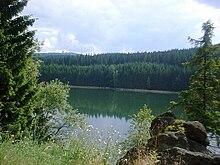
- Evangelical Lutheran Church: The nave with the three-sided choir end dates from 1617. The tower was added between 1692 and 1700. Its square floor plan merges into an octagon at the height of the roof ridge of the nave. A baroque dome with a lantern , tower button and weather vane (cross) concludes. The interior impresses with its almost classicistic simplicity. A monumental baroque cross of Christ hangs over a modern altar . Right in front of it is a baptismal angel with a baptismal bowl. The parapet of the three-sided gallery with integrated pulpit is painted with a symbolized cycle of the life stages of Christ, supported by a biblical quote in the frieze of the entablature. The organ , built in 1874, is the work of Johann Gotthilf Bärmig from Werdau and was expanded to 21 registers in the 1950s. The old carved altar from a Schneeberg workshop from 1646 with crucifixion and donors is now in the sacristy . The three-part steel bell ringing from 1919 was replaced in 2009 as part of a comprehensive tower renovation with new bronze bells, cast in the Grassmayr Innsbruck bell foundry . This was followed by the renewal of the church roof and renovation work on the interior.
- Dam : Built between 1949 and 1952, it serves to supply the Aue-Schwarzenberg area with drinking water and to protect against flooding. Around 6 million m³ of water are stored under a surface of 39.3 hectares behind a 58.4 m high gravity dam made of rubble from the nearby granite quarry. Idyllically located in front of the north side of the Auersberg , it has also been possible to hike over the dam wall since 2017.
- Experience charcoal making: Since 2019, visitors to the former quarry not far from the dam have been able to get to know everything about charcoal making, as well as other old trades in a craft barn.
- Köhlerweg: a moderately difficult hiking trail of 11.9 km in length on the trail of charcoal burning and other historical and ecological features. One stop is the glasses charcoal factory , the last of its kind in the Ore Mountains.
- Listed half-timbered and half-timbered houses
- Place pyramid on the parish square
- Further cultural monuments listed by the State Office for Monument Preservation Saxony
Sports
In 1899 the first sports club was founded in Sosa. Athletics, soccer, fistball, cycling and winter sports soon followed gymnastics and gymnastics. A ski jump was built in 1927, the sports field completed in 1929 and an open-air swimming pool opened in 1931. After the Second World War and during the GDR era, the sports club was renamed several times. There were sporting successes, also internationally, especially through winter sports enthusiasts, track and field athletes and in football, where SG Sosa achieved promotion to the GDR league in 1979 .
After the reunification , the BSG Empor Sosa became the sports club 1899 Sosa e. V. , from which the footballers developed in 1994 as FSV Sosa e. V. severed. In addition to the sports facility on Dürrer Berg , a new sports hall has been available next to the primary school for a large number of other clubs (including Kraftsportfreunde Sosa e.V. , Tennis Club Sosa e.V. ), school and leisure sports.
Sons and daughters
- Daniel Friedrich Hecht (1777–1833), mathematician and surveyor
- Gustav Moritz Franz (1816–1899), Protestant theologian
- Siblings Caldarelli , Ore Mountains singing trio
- Johannes Döhler (* 1926), politician, member of the Central Committee of the SED
- Ludwig Güttler (* 1943), trumpet virtuoso
- Frank Vogel (* 1957), District Administrator of the Erzgebirgskreis
literature

- Christian Heinrich Hecht : History of the Saxon mountain town Sosa in the Meisnian Upper Ore Mountains. Hof / Leipzig 1778. (digitized version)
- Sosa . In: August Schumann : Complete State, Post and Newspaper Lexicon of Saxony. 11th volume. Schumann, Zwickau 1824, pp. 250-253.
- Heinrich Gottlob Franz: Sosa in: Sachsens Kirchen-Galerie , volume: Section 9: The inspections: Chemnitz, Stollberg, Zwickau and Neustädtel. Verlag Schmidt, Dresden 1842 ( digitized version in the Dresden State and University Library )
- Richard Steche : Sosa . In: Descriptive representation of the older architectural and art monuments of the Kingdom of Saxony. 8th booklet: Amtshauptmannschaft Schwarzenberg . CC Meinhold, Dresden 1887, p. 66.
- Wilhelm Johannes Hilbrig: The Parochie Sosa , in: Georg Buchwald (Hrsg.): New Saxon Church Gallery . Ephorie Schneeberg . Leipzig 1902. ( Digitized in the State and University Library Dresden )
- The mining landscape of Schneeberg and Eibenstock (= values of the German homeland . Volume 11). 1st edition. Akademie Verlag, Berlin 1967, pp. 146–150.
- The mayor of the municipality of Sosa (ed.): A village celebrates. 800 years of Sosa - Heimatfest 2007. Sosa 2007.
- Lienhard Haufe: Sosa family book near Eibenstock (Erzgebirgskreis), Saxony 1589 - 1849. (= Central German local family books of the AMF , No. 82). Volume 1 and 2. AMF , Leipzig 2015, DNB 1136581391 .
Web links
- Literature about Sosa in the Saxon Bibliography
- Website of the community
- Private website about Sosa
- Historical photos from Sosa, SLUB / Deutsche Fotothek , accessed on April 23, 2020
- Sosa with contour lines on Mapcarta - The free map
- Sosa in the equidistant map 145: Section Eibenstock of the years 1875 , 1897 and 1904
Individual evidence
- ↑ Small-scale municipality sheet for Eibenstock, city. (PDF; 0.23 MB) State Statistical Office of the Free State of Saxony , September 2014, accessed on July 16, 2017 .
- ↑ Natural space map service of the Landschaftsforschungszentrum eV Dresden ( information )
- ↑ Ernst Eichler , Hans Walther (ed.): Historical book of place names of Saxony. Volume II: MZ (= sources and research on Saxon history. Volume 21). Edited by Ernst Eichler, Volkmar Hellfritzsch , Hans Walther and Erika Weber. Akademie Verlag, Berlin 2001, ISBN 3-05-003728-8 , p. 438, online . Explanations, abbreviations and the cited literature can be found in Volume III: Apparat und Register , online .
- ↑ a b Sosa. In: Digital historical directory of Saxony. Institute for Saxon History and Folklore V., accessed on April 23, 2020 .
- ^ Kurt Mielsch: Festschrift for the 300th anniversary. Existence of the church in Sosa in the Ore Mountains . In: Church council Sosa (ed.): Leaves of memory . Sosa 1917, p. 5 f .
- ^ André Thieme : The lordly foundation of the high colonization . In: Enno Bünz (Hrsg.): Ostsiedlung und Landesbau in Sachsen. The Kührener deed from 1154 and its historical context . Leipziger Universitätsverlag GmbH, Leipzig 2008, ISBN 978-3-86583-165-1 , p. 161 ff .
- ↑ Gerhard Philipp Heinrich Norrmann : Geographical and historical handbook of country, ethnology and national studies, first volume, second department, Hamburg 1786, p. 705 ( digitized version )
- ^ Paul Schulz: Archangel Penguins. SLUB / Deutsche Fotothek, 1927, accessed on May 9, 2020 .
- ↑ Christian Heinrich Hecht: History of ... , p. 73 ff., S. Lit.
- ↑ A village celebrates. , P. 11 f., P. Lit.
- ↑ A village celebrates. , P. 20 ff., S. Lit.
- ↑ A village celebrates. , P. 33 ff., P. Lit.
- ^ Carl August Hugo Burkhardt : History of the Saxon Church and School Visitation from 1524 to 1529. Reprint of the Leipzig edition 1879. Scientia-Verlag, Aalen 1981, p. 24 f.
- ↑ Conrad Benjamin Meißner: The Royal Saxon Elementary Schools Act of June 6, 1835 . Verlag von Bernh. Tauchnitz jun., Leipzig 1840, p. 10 . ( Digitized version )
- ^ Regional data, municipal statistics, Saxony. State Statistical Office of the Free State of Saxony, accessed on April 23, 2020 .
- ↑ Hans Brenner, Wolfgang Heidrich, Klaus-Dieter Müller, Dietmar Wendler: Nazi terror and persecution in Saxony - From the early concentration camps to the death marches. Ed .: Saxon State Center for Political Education. Dresden 2018, p. 531 .
- ^ Frank Reinhold: The march of the Berga beech forest prisoners. In: Museum Reichenfels Hohenleuben. Vogtland Antiquities Research Association of Hohenleuben e. V., September 15, 2008, accessed April 23, 2020 .
- ↑ Heimatfest 2017. Evangelical Lutheran Church Congregation Sosa, accessed on April 28, 2020 .
- ↑ O you mei Haamitland. Helmut Vogel a musical portrait to sing, make music & smile . ullmannmusic Musikverlag, Lauter – Bernsbach 2019, ISBN 978-3-948236-00-7 .
- ↑ A village celebrates. , P. 44, p. Lit.
- ^ Lienhard Haufe: Sosa family book near Eibenstock (Erzgebirgskreis), Saxony 1589 - 1849 . In: Central German local family books of the AMF, No. 82 . tape 1 and 2. AMF, Leipzig 2015.
- ↑ Bergbrüderschaft Sosa e. V. Accessed April 28, 2020 .
- ↑ a b Sosa charcoal burning experience. Köhlerverein Erzgebirge eV, accessed on April 28, 2020 .
- ↑ European Koehler Association e. V. Accessed April 28, 2020 .
- ^ Heinz Sprengel, Karl Josef Tielke: Charcoal burning and tar smelling are intangible cultural heritage in Germany . In: European Köhlerverein (ed.): The Köhlerbote . No. 10 . BUR Werbeagentur GmbH, Annaberg-Buchholz 2015, p. 2 .
- ↑ Sosa in the Erzgebirge, Germany (Saxony) - village church. In: Organ Database. Retrieved May 12, 2020 (German, Dutch).
- ↑ Verena Friedrich: Sosa . In: Ev.-Luth. Church council to Sosa (ed.): PEDA art guide . No. 347/1995 . Kunstverlag Peda , Passau 1995, ISBN 3-89643-007-6 , p. 4-15 .
- ^ Churches in the Auersberg area. Marketing pool Am Auersberg, printing: glasses, Eibenstock
- ^ Dorfkirche Sosa: Church of the Month September 2010. In: Stiftung KiBa . 2010, accessed May 12, 2020 .
- ↑ The Köhlerweg around Sosa. In: Ore Mountains Adventure Home. Ore Mountains Tourist Association V., accessed on April 28, 2020 .
- ↑ Inauguration of the new sports hall. Saxon State Chancellery Dresden, Prime Minister, August 16, 2019, accessed on April 23, 2020 .



